The eerie movie “Jaws” (1975) by Steven Spielberg was inspired by the dreadful reputation of the great white shark. It is the only remaining shark species in the genus Carcharodon and it belongs to the family of mackerel sharks, Lamnidae. Florida waters are home to more than 13 shark species, and the Great white shark forms an important part of the marine ecosystem.
At an average length of up to 15 feet — sometimes more, it is undoubtedly the largest, most powerful, and most dangerous predatory fish on Earth! How big are the largest individuals of this species ever encountered off Florida waters? The great white shark’s size is unbelievable.
What is the largest great white shark in the world? Let’s find out.
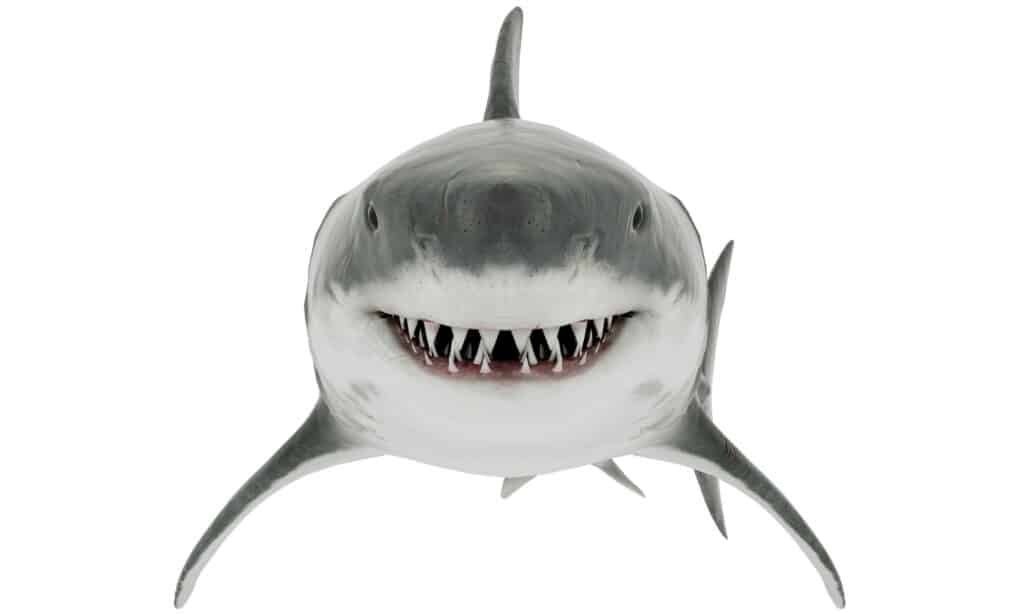
Great White Sharks are named for their white underside and gray upper body that blends with the sea from above.
©iStock.com/Sefa kart
How to Identify Great White Sharks
Noted for its formidable size, the great white shark is hard to miss. This species is named for its white underside and gray upper body (in shades of brown or blue), giving it an overall mottled appearance. The darker shade of its back blends with the sea from above; in contrast, it displays a slight silhouette against sunlight from below.
Like many other sharks, a great white shark’s mouth has up to 300 serrated teeth arranged in several rows. Compared to other shark species, they have larger eyes in proportion to their body size, with the iris of their eye being deep blue instead of black. This huge shark has a robust, large, conical snout and an exceptional sense of smell to detect prey.
Great whites are torpedo-shaped excellent swimmers with powerful tails that can propel them through the water at a speed of up to 16 miles per hour.
Where Do Great White Sharks Live?
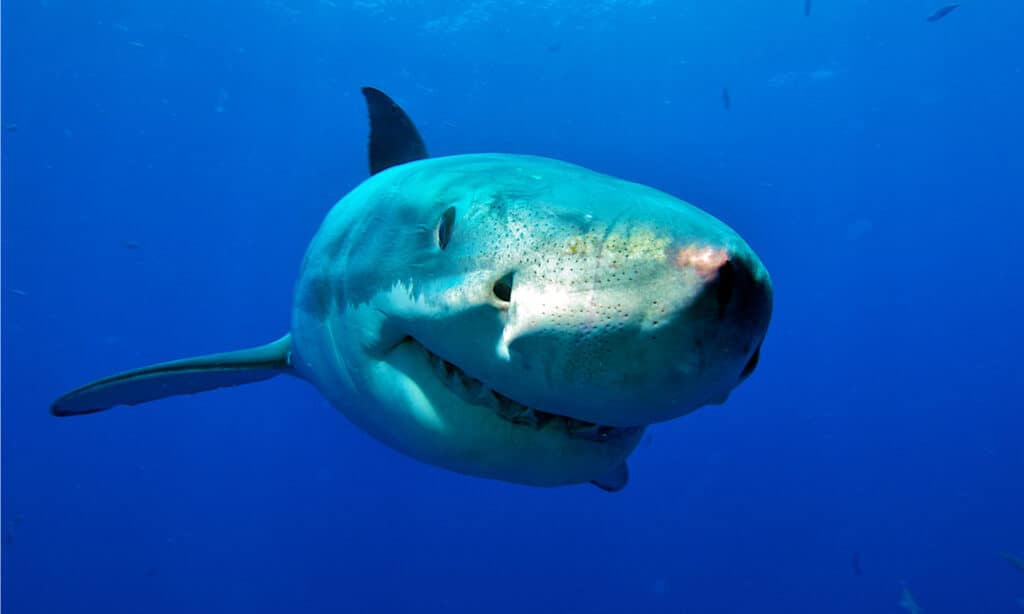
A large concentration of great white sharks can be found around Dyer Island in South
Africa
.
©Stefan Pircher/Shutterstock.com
The biggest great white sharks are found in almost all coastal and offshore waters with temperatures between 12 and 24 °C (53.6 and 75.2°F). They can live in both sub-tropical and temperate waters and are also known to move closer to the shores during the spring and summer seasons, making April and October the months of the highest shark activity.
The great white shark is an epipelagic species, therefore it’s spotted mostly in favorable feeding environments close to coastlines where there’s a large prey population, such as seals and sea lions. Larger populations of this species are found in the United States, especially in the northeast and California, Japan, South Africa, Chile, Oceania, and the Mediterranean.
A large concentration of great white sharks – perhaps one of the largest ever known – can be found around Dyer Island in South Africa.
How Big Are Great White Sharks?
True to their name, great white sharks are gigantic creatures. The great white shark’s size varies according to gender. Females are generally larger than males of this species. Female great whites, on average, measure 15 to 16 ft (4.6 to 4.9 m) while males are 11 to 13 ft (3.4 to 4.0m) long.
Great white sharks are also heavy-bodied, with adults weighing about 1,151 – 1,700 lb (522-771 kg) on average. Mature females can grow as large as 1,500 to 2,450 lb (680-1,110kg).
The Largest Great White Shark Found in Florida Waters
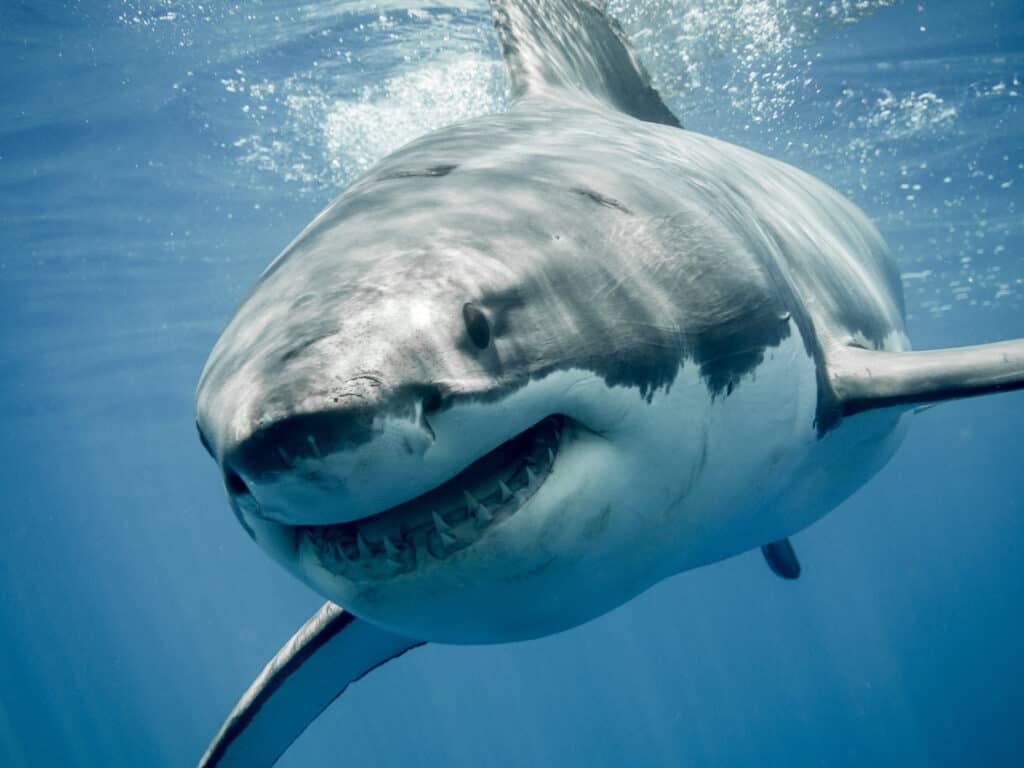
The largest great white shark pinged off the Gulf Coast of Florida waters was an individual named Scot, weighing up to 1,644 pounds.
©Ramon Carretero/Shutterstock.com
Florida waters are home to much marine wildlife. From the bull shark and dolphins to a variety of turtles, this coastline has a vast array of creatures both large and small but nothing can compare to the largest shark found in these waters, the great white.
What is the largest great white shark found in Florida waters? OCEARCH is a non-profit group that collects data on sharks by ‘tagging’ them in the ocean so that when a geo-tagged shark swims close enough to the surface of the water, its tracker will “ping” to disclose its location.
According to OCEARCH, various massive great whites have been spotted off Florida waters, including;
- The largest great white shark pinged off the Gulf Coast of Florida waters in March 2022 was an individual named Scot, weighing up to 1,644 pounds and measuring 12.3 feet in length.
- Another giant male white shark named Ironbound was tracked near the same locale, weighing nearly 1,000 pounds.
- Coming close second is another enormous great white shark named Breton, geo-located about 13 miles off Port St. Lucie coast in South Florida on June 6, 2022, and found to weigh 1,437 pounds and about 13 feet long.
- Sable is an 11.5 feet-long great white shark found along Florida’s coast and several other unexpected locations along the Gulf of Mexico. The massive shark, estimated to be about 900 pounds, was speculated to be pregnant at the time of discovery.
- Mahone, a huge specimen measuring 13 feet 7 inches and weighing 1,701 pounds, was the largest great white shark in the world to be tagged by OCEARCH. It was spotted swimming in the waters off North Carolina, though, not Florida.
Florida Beaches with the Most Shark Attacks and Sightings
Florida is known for its numerous beaches along the Atlantic and Gulf of Mexico. Among these beaches, there are five that have experienced the highest number of shark attacks.
Topping the list is New Smyrna Beach, located in Volusia County, with close to 200 recorded shark attacks since 1882. Daytona Beach, also in Volusia County, follows with about 46 shark attacks. Ponce Inlet, a small town with a population of just over 3,200, has had nearly 40 shark attacks. Cocoa Beach in Brevard County has recorded over 30 shark bite incidents, while the Florida Keys, an archipelago in Monroe County, has seen more than 20 shark attacks.
Despite these numbers, the likelihood of encountering a shark – especially a great white shark – and being bitten is extremely low, and it shouldn’t deter visitors from enjoying Florida’s beautiful beaches.
What is the Largest Great White Shark in the World Ever Recorded?
The largest great white shark in the world ever documented in history is a female shark named Deep Blue, in reference to her majestic beauty, estimated to be about 5,000 pounds (2.5 tons) and nearly 20 ft long. When she was discovered, she was heavily pregnant, which contributed to her enormous size. Researchers believe that Deep Blue is about 50 years old and is still not yet done growing. So she is expected to live at least another 25-30 years!
Another one of the largest great white sharks in the world ever measured was caught off Prince Edward Island in Canada in 1983 at over 17 feet (5.2 m) long and was listed as one of the world’s five most legendary sharks by the Discovery Channel.
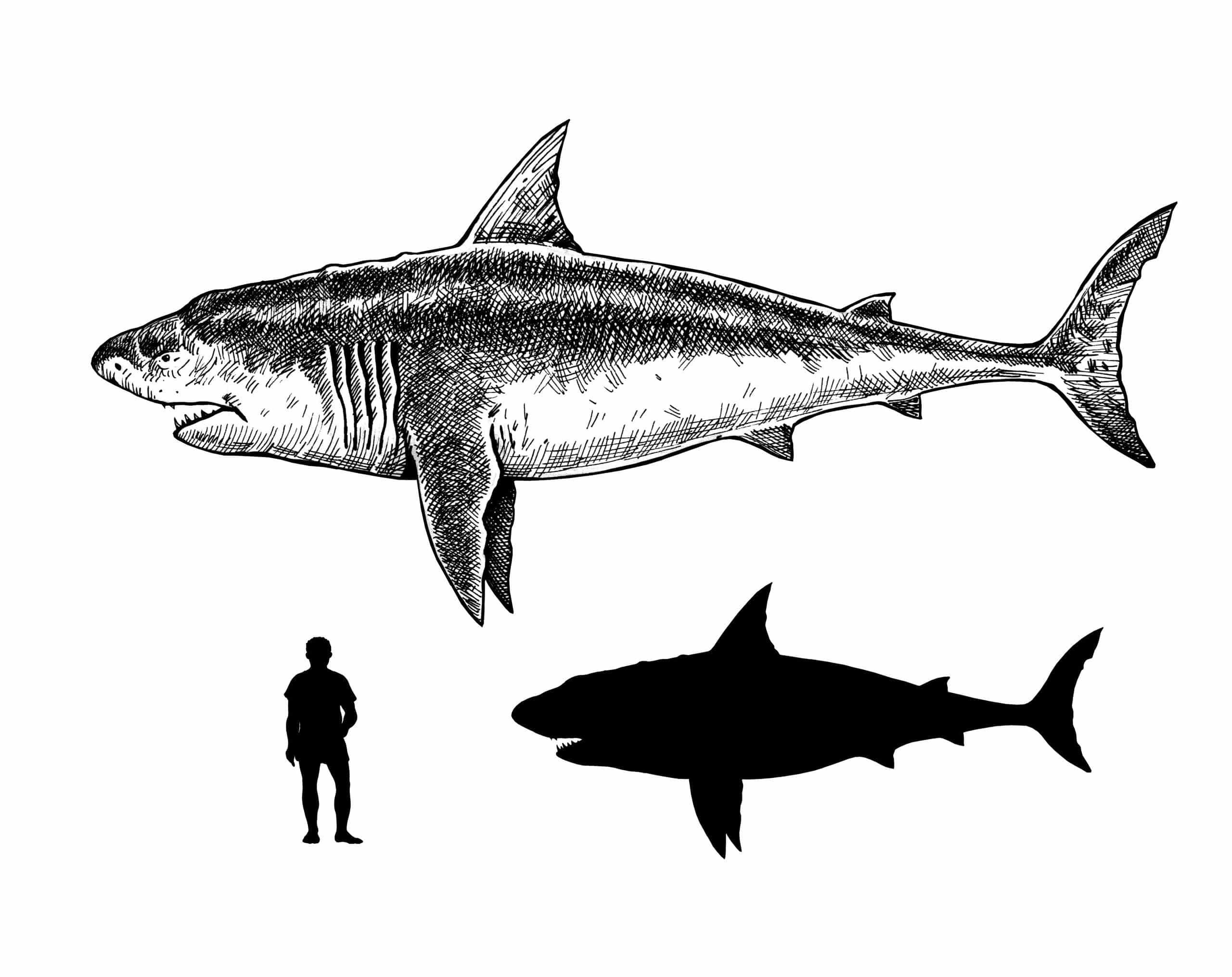
Megalodon Vs. Great White
©Sammy33/Shutterstock.com
Great White Shark Vs. Megalodon: Which is Bigger?
Even though Deep Blue is the largest great white shark ever recorded, surprisingly, she is not the largest shark specimen in the history of the world. That title is held by the prehistoric Megalodon, an extinct species of mackerel shark that lived approximately 2.3 to 3.6 million years ago. Regarded as a stockier version of the great white shark, it had an average length of 35 feet to up to 67 feet long! Their estimated body mass was between 105,000 pounds to a whopping 227,000 pounds –about 50 times larger than the great whites.
The megalodon has also been described as having a single tooth the same size as a human hand and large jaws that could easily fit a whole person. Unlike the great white shark which attacks prey from its soft underside, it uses its strong jaws to break through the chest and puncture the heart and lungs of its prey.
What Do Great White Sharks Eat?

The great white shark is currently considered the world’s largest-known predatory fish and is one of the primary predators of marine mammals, including prey as large as baleen whales. It also preys on other marine animals such as seabirds, seals, dolphins, and smaller whales. The biggest great white is an apex predator, whose only real predators are orcas.
Contrary to what was depicted in the popular novel ‘Jaws’ by Peter Benchley and its film adaptation by Steven Spielberg, great white sharks are not ferocious man-eaters.
In truth, humans are not the preferred prey of the great white shark in any form.
Do Great White Sharks Attack Humans?
Despite their fearsome reputation, great white shark attacks on humans are rare because humans are not their preferred prey. But of all shark species, the great white shark is responsible for the highest number of recorded human shark bite incidents, both non-fatal and fatal – about 333 documented unprovoked bite incidents on humans today, most of which were non-fatal. Nevertheless, there have been 52 fatal bite incidents. Most deaths were caused by victims losing blood from the initial shark bite rather than from whole consumption by great whites or critical organ loss.
Many great white shark bite incidents are often the result of a ‘test bite’ or ‘exploratory’ bite. This species test bites an unfamiliar object to identify what it is, so this may cause it to grab a human or surfboard that comes its way. Bites may also occur due to low water visibility or other situations that may distort the shark’s senses. In actuality, research has shown that because great white sharks prefer prey that is fat and rich in protein –like seals, humans are too bony for their liking and not considered worth predating on.
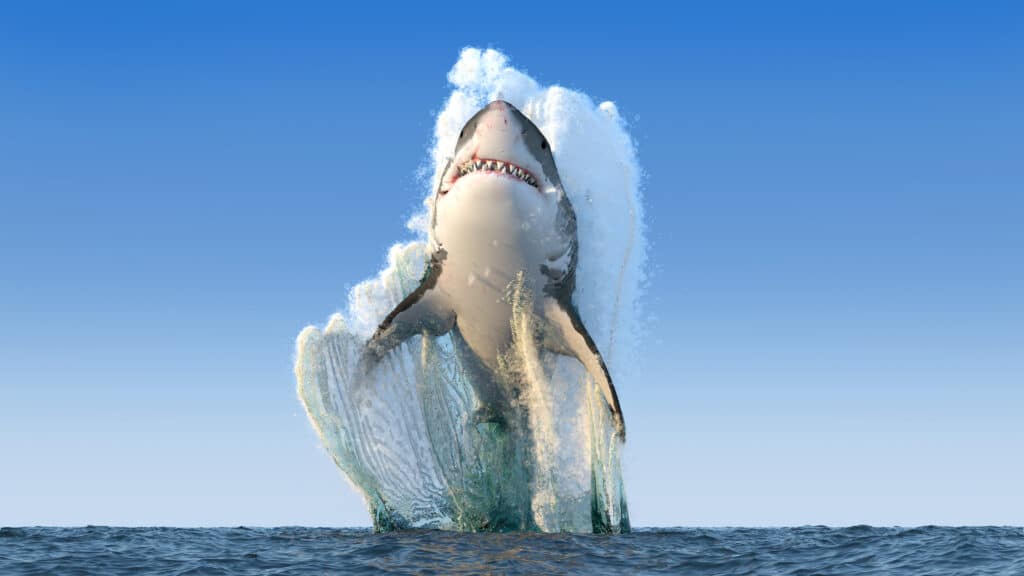
A massive great white shark leaped into the air in a grand display.
©Alexyz3d/Shutterstock.com
Great White Shark Lifespan
Recent scientific research has estimated the lifespan of great white sharks to be as long as 70 years or more —making this species one of the longest-lived cartilaginous fishes. In addition, research also shows that while male great white sharks take 26 years to reach sexual maturity, females take 33 years.
Great white shark pups are born between 2 and 12 at a time. While still young, these shark pups are mostly able to eat fish and small crustaceans. It’s only after they are fully grown that they are able to take down the large aquatic game that matures great white sharks are known for devouring.
Are Great White Sharks Endangered?
According to the IUCN, very little is known about the great white shark’s actual status or population numbers. However, this species is listed as “vulnerable” —just one step away from being endangered. Great white sharks have suffered a significant population decline from the 1970s until now, and the biggest threats are indiscriminate sport fishing and accidentally getting caught in fishing nets. The great white shark is included in Appendix II of CITES, meaning that international trade of the species requires a permit.
Summary of the Largest Great White Sharks Ever Found Off Florida Waters
According to OCEARCH, these massive great whites are the largest to have been spotted off Florida waters.
| Rank | Shark’s Name | Weight |
|---|---|---|
| 1 | Scot | 1,644 pounds |
| 2 | Breton | 1,437 pounds |
| 3 | Ironbound | 1,000 pounds |
| 4 | Sable | 900 pounds |
What Shark Species Face the Threat of Extinction?
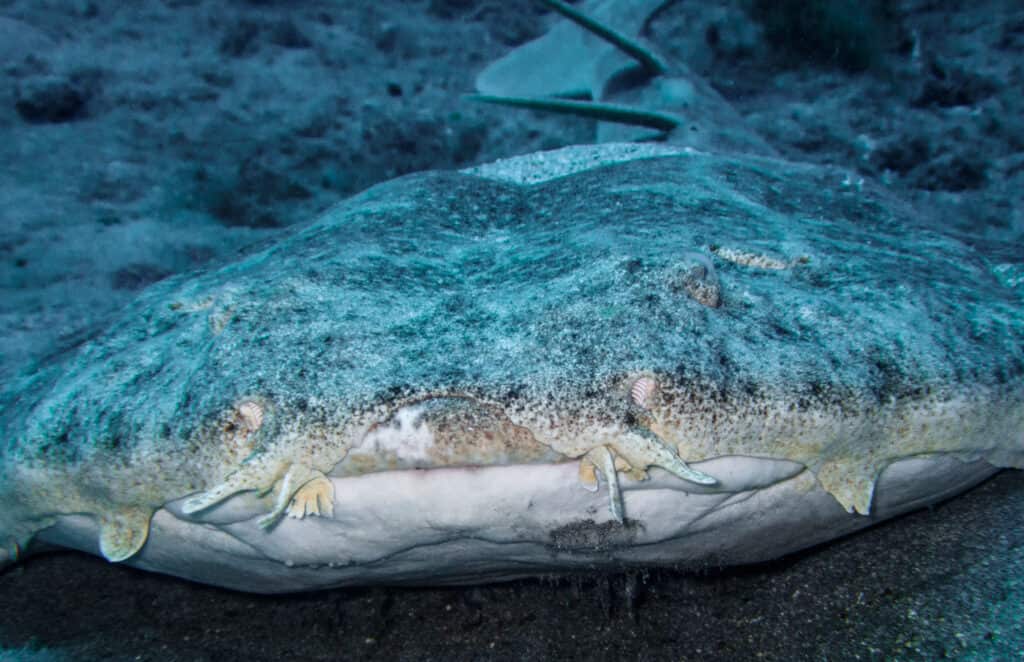
Angelsharks are listed as critically endangered due to overfishing, habitat loss, and degradation.
©LuisMiguelEstevez/Shutterstock.com
Great white sharks are considered a vulnerable fish species due to poaching and overfishing. Unfortunately, there are other shark species today that are listed as either endangered or critically endangered by the IUCN. Below is a list of some endangered shark species:
- Great Hammerhead Shark (Sphyrna mokarran) These sharks, which can be found in the Atlantic, Indian, and Pacific Oceans, as well as the Mediterranean Sea, are listed as critically endangered due to overfishing for the shark fin trade and habitat loss.
- Scalloped Hammerhead Shark (Sphyrna lewini) Like the great hammerhead, the scalloped variety is also critically endangered due to the shark fin trade. Additionally, they are vulnerable due to getting caught in fishing gear meant to catch other varieties of fish.
- Dusky Shark (Carcharhinus obscurus) These sharks are listed as endangered in the Northwest Atlantic Ocean, and vulnerable worldwide, due to overfishing for their valuable fins, meat, and liver oil.
- Whale Shark (Rhincodon typus) While these sharks are protected in many countries, they still fall victim to accidental entanglement in fishing gear, strikes from ships, and illegal poaching. They are listed as endangered.
- Angelshark (Squatina squatina) These sharks, found in the northeastern Atlantic Ocean and the Mediterranean Sea, are listed as critically endangered due to overfishing, habitat loss, and degradation.
- Basking Shark (Cetorhinus maximus) Historically, basking sharks were hunted for their liver oil, used to make vitamin A, lamp oil, and tanning leather. Today they are also hunted for their fins, and fall victim to net entanglement and collisions with ships.
The photo featured at the top of this post is © Martin Prochazkacz/Shutterstock.com
Thank you for reading! Have some feedback for us? Contact the AZ Animals editorial team.






